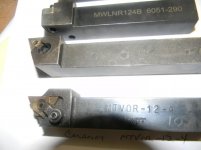After what seems like a million years, I have the 1024 running. I have two tool posts, a multifix A and an Algra Rapidue which is a Dickson clone. There were a bunch of holders for the Algra but most looked dickson as the flange on the adjuster was too thick. I surface ground them and intend to use them first as I need the algra to make a bolt for the Multifix. Tooling that cam e with the lathe are pictured below but no extra inserts. I'm new to most of this so I would like to know which of these is useful and worth buying inserts for. I'm learning about the nomenaclature ( reading threads here )but don't want to buy a bunch of useless stuff. I have rooms of useless stuff all ready. The 3/4" will work on either post.
View attachment 312341View attachment 312342View attachment 312343 Any advice is appreciated. Dave
Ermmm.. Carbides are magically diverse and capable technology, many long years, already. Fast-moving as to upgrades, too.
Those pushing CNC spindles balls to the walls to earn a few cents each PART need to be as up-to-date as possible lest some OTHER guy pushing a CNC spindle beats their price by two cents.
Good on 'em.
A(ny) hobbyist hasn't got the time, the budget, nor the mass of same-same alloy and same-shape parts to match that "optimization", even if he/we had the wish to do. Our "optimal" can vary from ONE job to the next, not even involve TWO of a thing.
Use what is common, cheap, and generally well-spoken of, all-around use. It WILL be obsolete by bleeding-edge metrics. And also JF get the job DONE more often that not.
Lazy, Iyam.
I've got more than a lifetime supply of HSS/Cobalt and Stellites put by, virgin blanks to some earlier Pilgrim's interesting grind, usable, touch-up-able, or reshaped altogether "my way".
That's all I really need. No further out-of-pocket spend required. Ever again.
"YMMV"
It is SUPPOSED to do.
Same as boats and camels.
Only ripe Durian fruit and fresh cat s**t are fungible goods.
Best to avoid BOTH, if you were not already aware!
Clobbered QCTP holders might also stinketh?
None of my concern. 4-Ways didn't cease working cheaply any more than the Bronze age ended for lack of Bronze nor the stone age for lack of stone.



 Any advice is appreciated. Dave
Any advice is appreciated. Dave

 Any advice is appreciated. Dave
Any advice is appreciated. Dave


